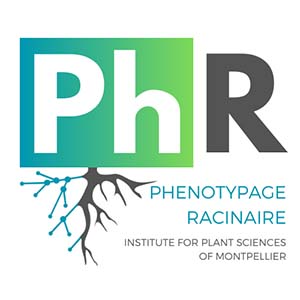
Root Phenotyping Platform

The Phenotyping of Root Development (PhR) facility is hosted by UMR 5004 “Institut des Sciences des Plantes de Montpellier”. Its main objective is to analyze, non-destructively and kinetically, the growth of the root system of seedlings of various species (mainly Arabidopsis, but also medicago, tomato, rice, rapeseed, etc.) grown in vitro.
The facility is developing high-throughput methods and tools to characterize the impact of cultivation conditions on plant root growth. These may include osmotic stress, nutritional deficiencies, excessive mineral elements, high CO2 levels or environmental stresses (temperature, light, etc.) in single or multiple combinations. These measurements serve as a basis for genetic or molecular physiological approaches.
Seedlings are grown in vitro on 120×120 mm (Small Model: PM) or 240×240 mm (Large Model: GM) petri dishes. The facility is equipped with an automatic image-taking system (HIRROS: Hight Resolution Root Scanner) located in a dedicated culture chamber, enabling temperature, hygrometry, lighting, and photoperiod to be adjusted according to the experimenter’s needs. Up to 150 PM boxes (750 Arabidopsis seedlings) or 72 GM boxes (360 rice seedlings) can be observed. Acquisitions are scheduled at intervals ranging from 2 to 24 hours.
The use of a 16-megapixel black-and-white linear camera, a telecentric lens, and a collimated LED backlight provide high-contrast images with a resolution of 20µm (including for Arabidopsis thaliana). The images generated can be analyzed automatically using the RootSystemTracker software developed in partnership with the AGAPi unit (Institut Amélioration Génétique et Adaptation des Plantes méditerranéennes et Tropicales).
The facility is involved in several research programs within the IPSIM unit and is open to the local, national and international scientific community through collaborations.
Access
- Access to the phenotyping facility is through scientific collaborations.
- Applications should be done via the « Application form » and emailed to Root Phenotyping facilitie. The platform steering committee will evaluate applications. Once a decision has been made, contact Amandine Crabos to organize the schedule and experiments.
Staff
Expertise
Area of expertise
Non-destructive and kinetic analysis of root system architecture of seedlings from various species grown in vitro
Services
- User support, including setting up the experiment and assistance during the experiment
- Access to IPSiM equipment for preparing culture media, plates and transplanting plants
- Secure image management and storage
- User training
- Assistance and advice in analyzing the images generated
Equipment / Technologies
- Dedicated growth chamber
- Temperature (12 to 35°C),
- Hygrometry (50% to 95%),
- Lighting: Vegeled Floodlight (40 to 350 µE)
- Photoperiod from 0 to 24H
- Imaging automate
- 72 large plates (240x240mm) or 200 small plates(120x120mm)
- Safe 50To data storage system
- Dedicated Image analysis working station
Training
- User training in in vitro culture
- User support, including experiment set-up and assistance during experiment progress
- Support and advice on image analysis
News
Publications
Thomas M, Soriano A, O’Connor C, Crabos A, Nacry P, Thompson M, Hrabak E, Divol F, Péret B (2023) pin2 mutant agravitropic root phenotype is conditional and nutrient-sensitive. Plant Sci., 329:111606
Fernandez R, Crabos A, Maillard M, Nacry P✉, Pradal C✉ (2022) High-throughput and automatic structural and developmental root phenotyping on Arabidopsis seedlings. Plant Methods, 18(1):127
Berger N, Demolombe V, Hem S, Rofidal V, Steinmann L, Krouk G, Crabos A, Nacry P, Verdoucq L, Santoni V✉ (2022) Root membrane ubiquitinome under short-term osmotic stress. Int. J. Mol. Sci., 23(4):1956
Kupcsik L, Chiodi C, Moturu TR, De Gernier H, Haelterman L, Louvieaux J, Tillard P, Sturrock CJ, Bennett MJ, Nacry P, Hermans C✉ (2021) Oilseed rape cultivars show diversity of root morphologies with the potential for better capture of nitrogen. Nitrogen, 2(4):491-505
Smokvarska M*, Charbel F*, Platre MP*, Fiche J-B, Alcon C, Dumont X, Nacry P, Bayle V, Nollmann M, Maurel C, Jaillais Y, Martinière A✉ (2020) A plasma membrane nanodomain ensures signal specificity during osmotic signaling in plants. Curr. Biol., 30(23):4654-4664.e4
Quality
The facility has adopted a continuous improvement approach
